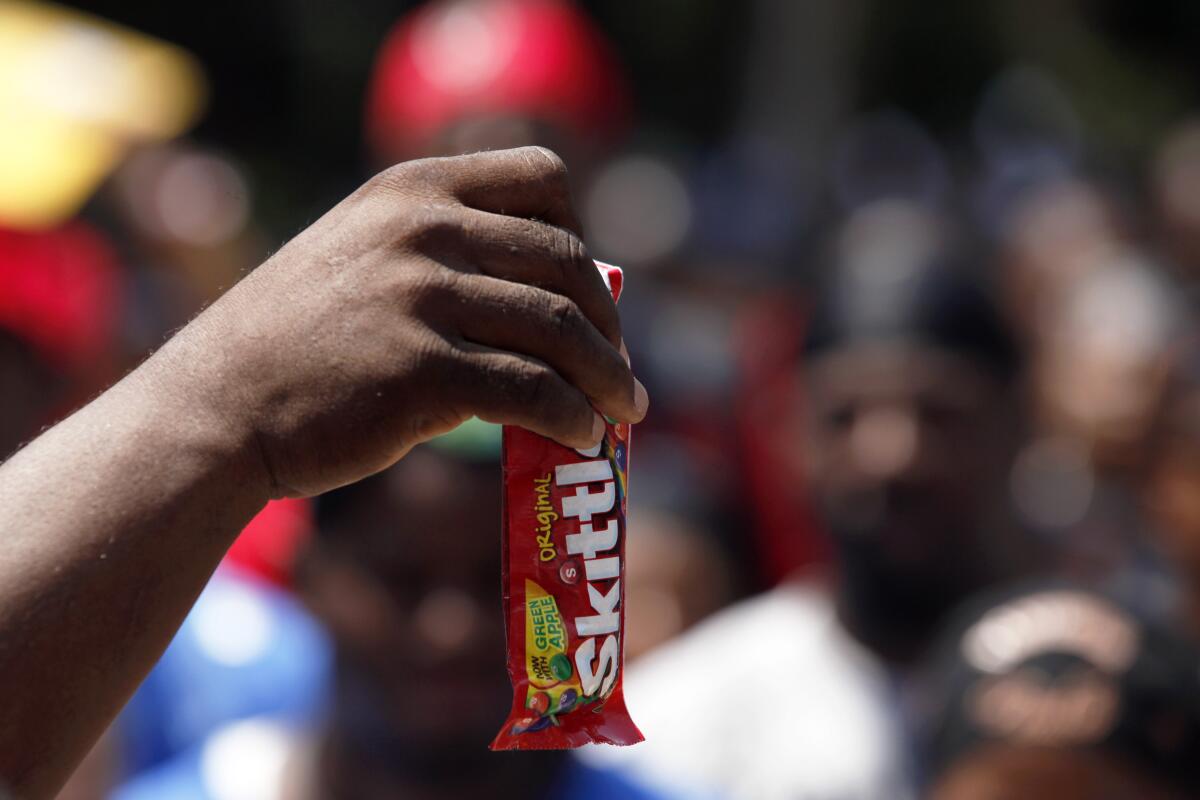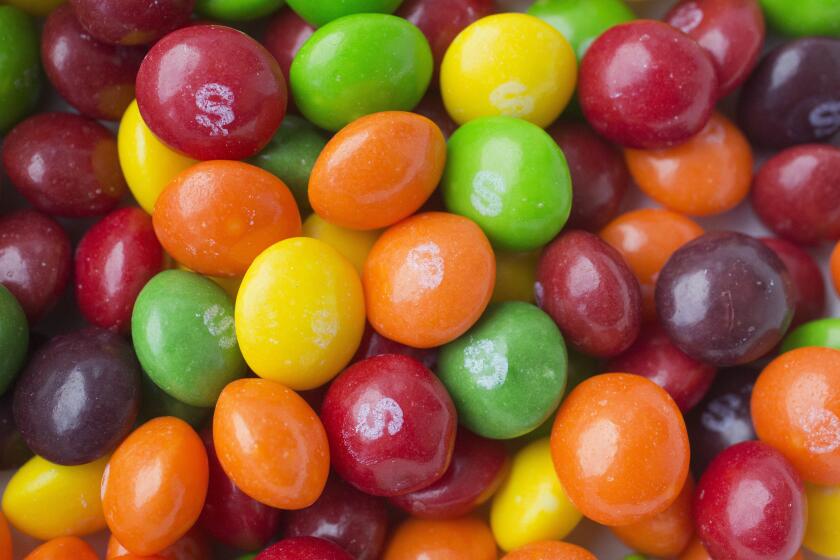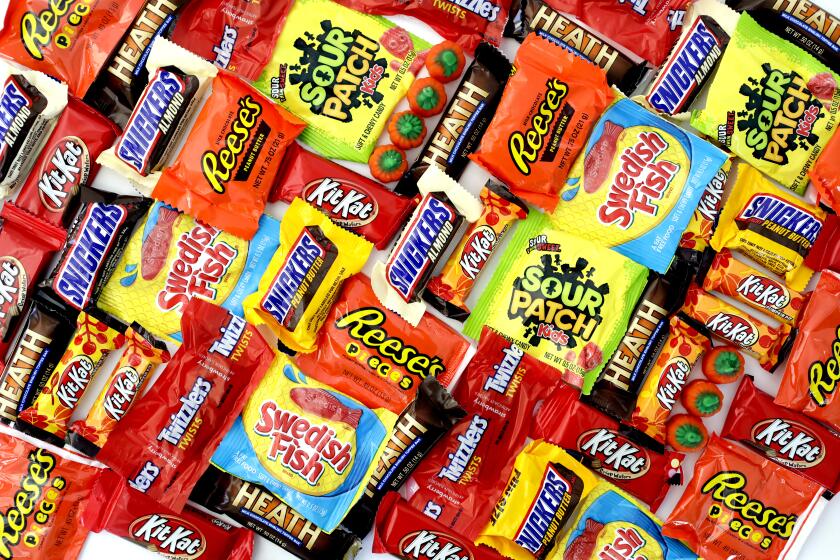Relax, candy lovers. No one is trying to ban Skittles. Well, not exactly

- Share via
Scratch the surface of a Skittles and, wow, you will find so much more than a chewy fruit-flavored sugar bomb. The shiny candy is a bit like a Rorschach test; you see what you want to see in those rainbow-colored morsels.
In 2016, for example, Donald Trump Jr. looked at a bowl of Skittles and saw suicide bombers. I’m not making this up.
Trump Jr. tweeted a photo of a bowl of Skittles with the incomparably insensitive message, “If I had a bowl of Skittles and I told you just three would kill you, would you take a handful? That’s our Syrian refugee problem.”
The unamused included the image’s photographer, a former refugee who said his shot was used without permission, and Mars Wrigley, the candy giant responsible for making most of the sugary snacks that keep pediatric dentists in business.
“Skittles are candy. Refugees are people,” said a Mars Wrigley spokeswoman. “We will respectfully refrain from further commentary as anything we say could be misinterpreted as marketing.”
That same year, during Pride Month (and every June since), Skittles began temporarily changing the color of its candies to white, as a gesture of support for LGBTQ rights.
“Only one rainbow matters during Pride,” the company has written on its packages. Of course, this did upset some folks, who thought changing the candies from rainbow-colored to white was racist. (And, yes, I did chuckle as I typed that.)
A proposed California law would ban the sale of foods, including Skittles and other snacks, that contain certain ‘dangerous chemicals.’
Once again, Skittles finds itself in the crosshairs. Well, Skittles and a whole bunch of other snacks Americans — especially kids — love to consume.
Many processed food products, it turns out, contain one or some of five possibly toxic ingredients that California Assemblyman Jesse Gabriel, a Democrat from Encino, is proposing that the state outlaw. If the bill, which is scheduled to be heard in committee in April, becomes law, California would be the first state to ban these ingredients by banning foods that contain them.
“Californians shouldn’t have to worry that the food they buy in their neighborhood grocery store might be full of dangerous additives or toxic chemicals,” Gabriel said last month in a news release announcing the proposed ban. “This bill will correct for a concerning lack of federal oversight and help protect our kids, public health, and the safety of our food supply.”
The targeted ingredients have been linked to health issues, including hyperactivity in children, reproductive problems, decreased immune response and an increased risk of cancer.
The offending chemicals, all of which are deemed safe to consume within limits by the Food and Drug Administration, are red dye No. 3, titanium dioxide, potassium bromate, brominated vegetable oil and propyl paraben. They make food last longer, taste better or look better, and they’re found in Nerds, Hot Tamales, Peeps, cake icing and strawberry-flavored drinks such as Nesquik, PediaSure, Ensure and Yoohoo, among other products.
Skittles parent company Mars faces a lawsuit over the use of the toxin titanium dioxide in the rainbow candy.
Oddly enough, as many food experts have pointed out, the FDA banned red dye No. 3 from cosmetics all the way back in 1990. This raises the question: Why is it OK to eat it if it’s not OK to brush it on your cheekbones?
From what I can tell, this bizarre state of affairs seems to be the result of bureaucratic inertia.
The FDA approved the use of red dye No. 3 in food and supplements back in 1931, long before there were studies showing that it could cause cancer in laboratory rats in very high doses. (Which, of course, does not necessarily mean it has the same effect in human beings.)
In 1990, when the agency finally did have evidence about the link between the dye and cancer in animals, it banned red dye No. 3 from all cosmetics.
“But at that point,” according to Consumer Reports, “the color was already on a permanently approved list for food.”
A new study finds an association between erythritol, a popular sweetener, and heightened cardiovascular risk.
“In 32 years, there’s millions and millions of children who have been exposed to this chemical who didn’t need to be,” Thomas Galligan, a food scientist at the Center for Science in the Public Interest, told the publication.
Unsurprisingly, food manufacturers have fired back at the California proposal.
The Consumer Brands Assn., which used to go by the name Grocery Manufacturers Assn., sent a letter in opposition. It accused lawmakers of attempting to preempt the federal and state regulatory agencies whose job it is to ensure the safety of the food supply.
“All five of these additives have been thoroughly reviewed by the federal and state systems and many international scientific bodies and continue to be deemed safe,” it wrote.
Well, not exactly.
The European Union has already banned these ingredients and many others that continue to be used in American food. In order to keep peddling their wares in European countries, food-processing companies have reformulated their products to comply.
“I love Skittles. I love Wild Berry Skittles. I eat them all the time,” Gabriel told The Times last week. “I would vote against a bill to ban Skittles. What we’re really trying to get them to do is to change their recipes. All of these are nonessential ingredients.”
So relax, Skittles fans. Nobody is trying to ban your favorite snack.
As the parent of a sugar-crazed middle schooler, though, I kind of wish they would.
More to Read
A cure for the common opinion
Get thought-provoking perspectives with our weekly newsletter.
You may occasionally receive promotional content from the Los Angeles Times.














